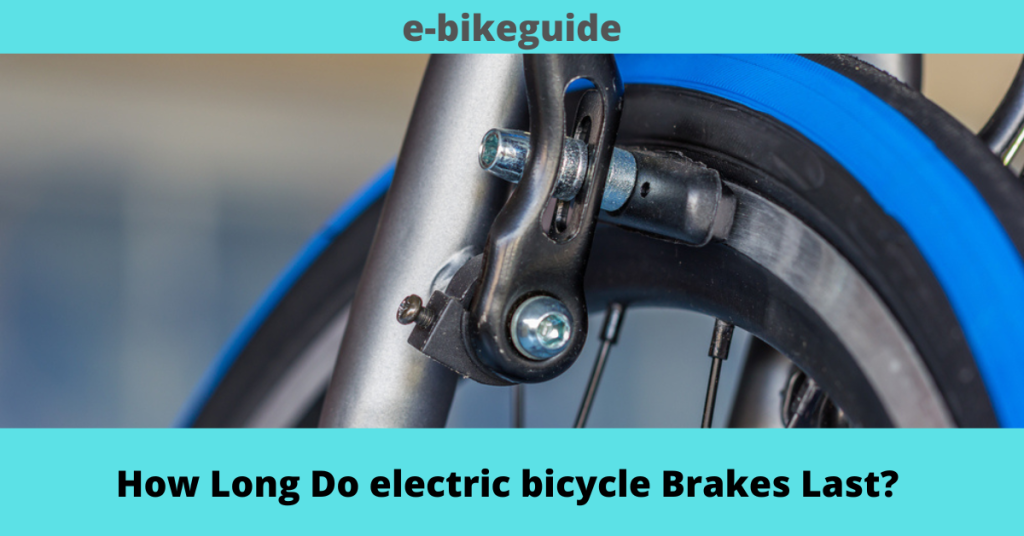
The brakes of an e-bike are very important as they are one of the safety factors in a bike. So owning an e-bike means taking good care of your bike brakes. So we can clarify the answer to the above question through the paragraphs below. Let’s find out how long your bike brakes last.
Normally the manufacturers say that ebike brakes can last about five years. But this depends on how you use it and the manufacturer’s quality of the parts. So, according to the quality, it might vary from 2 to 5 years maximum. As the internet says, the rim brakes endure 3000miles, and the disc brakes endure 6000miles. So this is the lifespan of the brakes, but there might be another problem. Because there will be some parts (pads, rotor) that you might have to change over the years.
So the parts inside the brakes don’t need much analysis. You can know if you have to whether to alter them without much effort cause it’s all numbers. You can measure them and find out.
How do you determine when to replace the brake rotors on your e-bike?
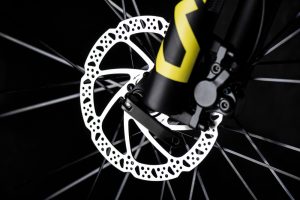
1-Following the Manufacturing guides
Usually, all the manufacturers provide a rotor with a minimum thickness. But there’s a limit to that, so when you reach the limit, you have to change the rotor. So before that, you should measure the sizes of the thickness; it’s a must to measure to see if it is worn out or not. Because the wearing out can affect the pads directly, so you might have to change the rotor and the pads both at the time. It’s better if you change it before extending the minimum thickness.
2- Comparing the thickness of both rotor sides.
So another way is comparing the thickness of your ebike rotor. It’s a must to check both sides. You will be able to find the difference between them. The difference should be less than 2 mm in length, so if it is more than 2mm, you should change the rotor of your ebike.
3-Checking the braking surface using a paper clip.
So you might not have the required tools to measure your rotor’s thickness, but there’s another way that might help. You can use a braking system using a paper clip surface to check the thickness. Slowly pass the clip on the surface, and if that feels rough or feels like it has something in the end, it means You must alter it. the rotor immediately before its effects on the pads.
4- If you start hearing noise while riding.
Another way to find out is when you start hearing a nice while riding your bike. This noise typically increases when you use the brakes too much. This can be a result of your bent rotor. To know that, you should put it on a horizontal surface and check if the rotor is horizontally aligned or has gaps within the surface and the rotor. Most people might suggest that you can rebend a bent rotor, but it is not working. So instead of trying to fix your rotor by rebending it, you should go for a change. Be quick, or else you might harm the brake pads too.
When should you change your ebike brake pads?

One of the essential parts of an e-bike is their brakes pads. Because the safety of the rider and also the other people around the rider depends on the brakes. Imagine if you’re riding faster on your bike and see some people crossing the road, so you apply brakes to stop the cycle. But it doesn’t work! This can cause danger for both parties, and you’ll also get into trouble. So why cause a problem when you can simply change it when you see you have worn out brakes?
So usually, the minimum thickness of an e-bike brake pad that needs to change is 1mm. so when your brake pads reach this amount, you should immediately change it.
We discussed in the previous part when to change the brake rotor, and here we will be discussing when to change the brake pads of your ebikes.
1- When you start hearing a squealing noise while using ebike brakes
So there are some signs that will show you when to change the brake pads and of the frequent signs is the squealing sound. This will be out by the bike when you use the brakes. This sound is deafening and clear, so you can clarify that you should change the pads as fast as possible. This problem doesn’t only occur in used brakes but also in newly new brake pads. This is because of the poor quality of the product. So when you’re buying an e-bike, it is a must to check; you should take a good look into the quality of the parts of your bike.
2-Using a caliper to measure the thickness.
Here’s one of the easiest ways to determine your brake pads’ thickness. It is by using a caliper. This can clarify whether you want to change the pads or not, so typically, if the thickness of your brake pads is 2 mm or more, it is acceptable to an extent, but if the thickness reading is below 1mm, it’s a sign that you should replace the brake pads of your bike.
3- Use business cards to measure ebike brakes pads thickness.
You might not have the required instruments to check the thickness of your brake pads because not everyone has a caliper in their home. So instead of a caliper, you can use a business card. Usually, the business cards are 1mm thick. So if the brake pads and the business cards are not equal, you can clarify that the thickness is below 1mm. This means you should replace the brake pads.
4-Needing extra effort using the lever
In some situations, you might figure out that it needs more effort to press the lever to decrease your bike’s speed. So that means that you should change the brake pads. So we can say this is one of the important signs as you can discover this only when riding the bike. But this is quite risky. Because if you want to stop or reduce the bikes in urgent situations, you might not be able to, so it’s better if you check the thickness of the pads using the above methods before taking your bike on a ride.
5- Oily ebike brake pads.
Another way to determine when to change the brake pads is when the brake pedals look dark in color, more like they have oils on the surface. They usually are worn out from grease and oils, so these can appear on the surface of your brake pads. If you see this, you can immediately replace the brake pads, so you won’t have to face difficulties on the roads when riding the bike. This is the most appreciable sign as anyone can see it with bare eyes without using any equipment.
What Makes The Brake Pads Wear Out Fast?
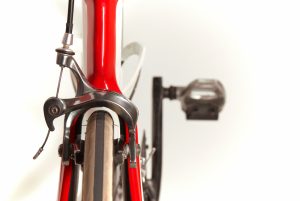
There can be many reasons that can change the efficiency of your ebike brake pads. These are some of the factors that affect the lifespan of the brake pads
- Quality of the brake pads used in your bike
- Type of material used for your brake pads
- Weather conditions of where you ride your ebike
- The environment is where you’re riding
- Weight of the bike and the rider
- The way you apply the brakes when stopping( riding style)
What Type of Brake Pads for eBikes Is Best?
Typically there are no perfect brake pads that fit perfectly to all riding conditions. They have different type of quality and has many advantages and disadvantages varying from product to product. It differs according to the riding conditions you’re under.
If you’re having trouble with choosing what type of brake pads you should use for your ebike, you must read the following options. As we said, there are no perfect matches, but there can be many benefits from each kind. Read the article and decide what you’re going to choose for your ebike.
Mainly there are three types of brake pads. These consist of different components, and you can use them for various purposes. Here as follow,
- metallic brake pads
- organic brake pads
- semi-metallic brake pads
Sintered/ metallic brake pads
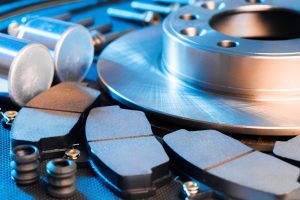
These brake pads consist of metallic components. So because of their metallic Nature, they are effortless to use and very durable for bike riders with different riding styles. And also, these pads don’t wear quickly. It takes some time to wear off because of the quality of these pads. And also they have a strong braking power. These work so well in wet conditions and sharp descents. The metallic particles used to make these pads handle high-temperature levels, but the heat that comes within the brake pads transfers heat to the caliper.
This can cause damage to the brake pads. These types of brake pads need some time for bedding in. so before taking it for a ride, you should warm it up a little bit; after that, you will be able to experience the whole performance of your bike. This problem for some riders is that these pads make a loud noise. But also, these are very helpful when riding on rocky and muddy roads and wet conditions. Metallic pads are best for those conditions, so you do not have to worry about the noise, as this has many advantages.
Pros;
- Wearing off is slow
- It works perfectly in wet conditions and on steep dives
- able to handle high temperatures
Cons;
- makes a loud noise
- needs to be in a “bedding in” time
- can cause damage to the caliper
Organic brake pads

This brake consists of carbon, fiberglass, Kevlar fibers, and rubber in a mix of resin. They work perfectly when there’s not much weight on them, or your riding style is very calm. So not recommended for aggressive riders and also overweight riders. This is because they have soft components. Unlike metallic pads, these do not make any noise when riding. Riders should put heavy stress on this rotor of the bike. They only need a short bedding time, so this is convenient to use as it doesn’t need much of a warm-up before taking fr a ride.
As with every other brake pad, there are also many advantages as well as disadvantages. one of the problems is that you can’t use them on long descents as it won’t work very well in that condition. Because if you take this for longer rides, the braking pads will get heated. When there overheat, the organic pads won’t work well and will have weak braking power because the soft components get wet quickly. But these are best if you like to ride your bike peacefully without loud noises. You can ride on flat, smooth surfaces with these organic brake pads.
Pros;
- organic pads don’t make any noise
- Doesn’t need much time for “bedding in.”
- very convenient on brake rotors
Cons;
- Wear off easily and quickly
- Can’t bear high-temperature conditions
- won’t work well in wet and slippery conditions
Semi-metallic brake pads
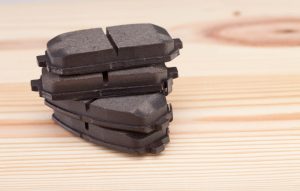
These pads are a mixture of organic and metallic compounds. You can even notice in the name too. Typically, this has both the features, the disadvantages, and the advantages are similar. Semi-metallic pads are much more durable than organic pads but have weak braking power as metallic pads. Also, they don’t make a loud noise like the metallic but are not as quiet as organic pads even. These pads do not wear off quickly and are able to handle high temperatures. It also needs much bedding in time and works perfectly in wet conditions.
These pads are best for people who are interested in both organic and metallic pads as it has both features. So if you want the benefits of both of them, you can use this but don’t forget that it also comes with the disadvantages of these two. So before choosing what is best for you, you can consider the pros and cons of both organic and metallic pads and decide what type of brake pads is best for you. According to the price, the metallic pads are the most expensive and the cheapest is organic brake pads. So you can go for s semi-metallic pads if you prefer both.
Pros;
- Works better in wet conditions
- doesn’t make a loud noise like metallic pads
- the “bedding in” time is shorter than sintered brake pad
- wear off process is slower than the organic brake pad
Cons;
- weak braking power
- because it has both components, the performance is not well at sometimes
In conclusion, we can say that you can change your ebike brakes in 2 to 5 years of use. This depends and varies according to your riding style and using the parts correctly. With the above information provided in the previous paragraphs, you might get an idea of when to how to replace the brakes of your ebike. It is also a must to check the pads and the rotor of your bike brake every two months of use if you want to keep your bike healthy and perfect.
